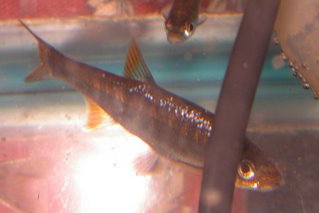Christian showed me an interesting graphical representation of her work on
Dactylogyrus gill parasites yesterday. Her raw data show little difference between the two creeks we've studied in terms of parasite load per fish, and little difference between scarlet shiners and striped shiners in parasite load. Christian restated our results as a time line of what was the maximum number of parasites we found in any one fish, beginning with fish from a year ago. What her trend line shows is that in Limestone Creek in the winter and spring we never found fish with more than two parasites in a gill, and by the end of the summer we were finding fish with four. The other creek, Swan Creek, had a steady rate of three parasites per fish as a maximum. This might not sound like much, but it would be consistent with fish growing over the summer and being a better target for larval parasites to find. This may actually also show that Limestone Creek could be considered a healthier creek, with a cyclicity of parasite infestation. I've got to flesh out that thought and come up with a fuller explanation but I'm excited at the thought (no, really!).
I also talked to Kevin today about our various mapping projects. It hit me that our project to map the known occurrences of the stippled studfish,
Fundulus bifax, shows that the known range of this species is five counties in east-central Alabama, and most of these locations are not just in the Tallapoosa River drainage, but in eastern tributaries of the Tallapoosa especially in Randolph County. This could well be a sampling artifact. But it informs what could be a good survey in this region to determine the species' status. The species seems to have disappeared from Georgia, and the Alabama range is better thought of as three counties since two of the occurrences are in counties within 3 km of an adjoining county with more known sites. I suspect that it would be easy to make a case for this species to receive protection under the Endangered Species Act. I don't think it will happen, but it should. You heard it here first.




